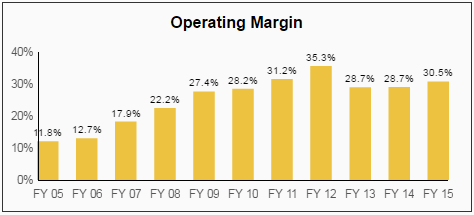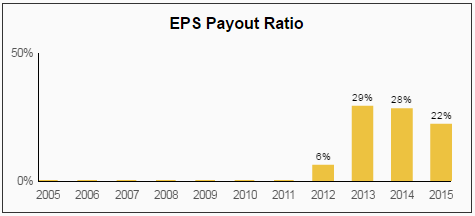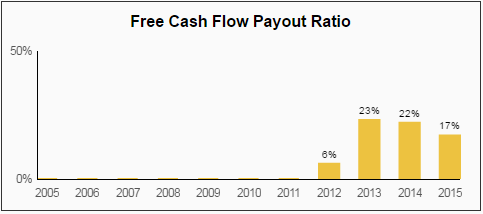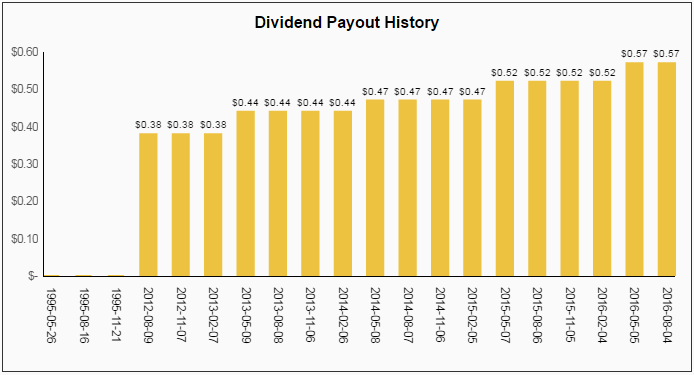Apple (NASDAQ:AAPL) is a blue chip stock that recently reinstated the dividend. Since becoming a dividend payer again in 2012 (it was suspended from 1996-2011), they have increased the quarterly dividend by 50% from 38 cents per share to 57 cents.
With a relatively low payout ratio, high returns on invested capital, and an extremely valuable consumer brand, Apple looks undervalued at only 13x 2016 earnings. Warren Buffet’s lieutenants certainty agree as Berkshire invested over a billion dollars in the company this year.
However, in a world where technology trends change drastically quickly, should investors count on Apple to deliver sustainable dividend growth?
Business Analysis
Apple is a global technology company with a rich history of product innovation. In fiscal year 2015, they generated sales of roughly $234 billion dollars. To put some context around this colossal sales number, it is larger than the GDP of many countries.
In general, the technology industry is a difficult industry to invest in for dividend investors due to the speed at which trends can influence competitive positions.
The same factors that have allowed Apple to be extremely successful could just as easily go against the company if a competitor were to come out with a far superior product or if a new innovation were to displace the iPhone entirely.
Besides paying attention to all the usual important financial ratios, dividend investors need to pay attention to the sustainability of the current margin structure, projected key product growth rates, and Apple’s capital allocation.
Apple operates the business through key product lines including the iPhone (66% of sales), iPad (10%), Mac (11% ), Services (8.5%), and Other Products (4.5%).
Apple generates enviable economics with returns on invested capital significantly above its cost of capital driven by 30%+ operating margins.
Source: Simply Safe Dividends
Margins have significantly increased from around 12% in the pre-iPhone years close to a decade ago. In fiscal year 2006, Apple’s main sources of revenue came from the Mac and iPad. Clearly the economics of the business have changed with the introduction of the iPhone.
Source: Simply Safe Dividends
Some reports put the gross margins on the iPhone 6 at nearly 70%. This is a huge margin and obviously helped drive up the company-wide margins well into the 30% range.
Furthermore, Apple’s margin is well in excess of estimated Android phone manufacturer (HTC, Sony, LG, Samsung (KS:005930), etc) margins of flat to 10%.
The only reason Apple can generate such a superior economic profile relative to peers has to be due to brand power, capturing the full economics of the phone (software and hardware), better terms from suppliers, or a superior product. In fact, it is likely that they benefit from all of these factors.
Given the current business mix and way the business has evolved over the past decade, the sustainability of iPhone margins are the key to maintaining the robust operating profile.
Clearly this could change if Apple develops a breakthrough new product or service. After all, few predicted back in the early-to-mid-2000s that smartphone adoption would take off like it did and that Apple would be the one to capture the majority of the value from the market.
Assuming that the business mix remains the same, the key to the sustainability of the current operating profile and future dividend increases is maintaining the iPhone economics.
A current iPhone 6s costs $100 more (roughly 15% higher price point) than a Galaxy S7 despite the Samsung phones having a better display and camera, more storage, and a host of other features.
If people were simply interested in the specification and features, then purchasing the iPhone at a higher price point does not make sense. Instead people buy based on brand and user experience. After all, if the average person is unable to seamlessly navigate all the features, then the features don’t add any value.
Also, the way most iPhones are purchased enables very attractive pricing. In 2015, 76% of US shoppers bought phones through their carrier. This means that there wasn’t the upfront $600+ sticker shock of purchasing the phone. Instead, the phone cost is built into the monthly cell phone bill. This is akin to financing a car rather than paying cash up front.
The most recent data point indicates that the pricing dynamic in the market is still healthy. Apple recently released their new iPhone 7 family, and some versions are at a higher price point.
While growth investors will be paying attention to the latest news on iPhone shipments and product cycles, the number one concern for dividend investors needs to be on the current margin structure. For now it appears that the iPhone economics appear intact.
Dividend Safety Analysis: Apple
We analyze 25+ years of dividend data and 10+ years of fundamental data to understand the safety and growth prospects of a dividend. Apple’s dividend and fundamental data charts can all be seen by clicking here.
Our Dividend Safety Score answers the question, “Is the current dividend payment safe?” We look at factors such as current and historical EPS and FCF payout ratios, debt levels, free cash flow generation, industry cyclicality, ROIC trends, and more.
Dividend Safety Scores range from 0 to 100, and conservative dividend investors should stick with firms that score at least 60. Since tracking the data, companies cutting their dividends had an average Dividend Safety Score below 20 at the time of their dividend reduction announcements.

Apple’s Dividend Safety Score is 95, which indicates that the dividend is not only much safer than the average dividend-paying stock in the market, but actually one of the safest overall.
The strong safety score is driven by relatively low payout ratios, a healthy balance sheet, strong business economics, and low industry cyclicality.
Since initiating the dividend in 2012, Apple’s free cash flow and EPS payout ratios have stayed below 30%. For 2016, they are expected to generate EPS of $8.28 and pay dividends of $2.23 per share. This implies a very comfortable payout ratio of 27% for 2016.
Source: Simply Safe Dividends

Source: Simply Safe Dividends
Apple’s balance sheet is one of the healthiest in corporate America. As of the end of the second quarter 2016, they have over $18 billion in cash and another $213 billion in short and long-term marketable securities.
These marketable securities are mostly composed of U.S. treasuries, corporate debt, and mortgage and asset-backed securities.
Offsetting this cash and marketable securities is $12.5 billion in commercial paper and a little over $72 billion in current and long-term debt.
Overall, Apple has over $145 billion in net cash and marketable securities on the balance sheet.
To put some context behind just how much money sits on Apple’s balance sheet Pepsi, IBM (NYSE:IBM), Walt Disney Company (NYSE:DIS), Medtronic (NYSE:MDT), Mastercard Incorporated (NYSE:MA), and a whole host of other blue chip, multi-national businesses have a market cap that is less than just the net cash and marketable securities on Apple’s balance sheet.
On an annual basis, Apple pays about $12.2 billion in dividends. This means that Apple can cover the current annual dividend payments for around 12 years with just the net cash and marketable securities on hand.
While the majority of the cash and marketable securities is located outside the U.S. and is not easily available for a tax efficient payout, Apple can issue debt in the US to finance capital returns to shareholders. We do not expect this dynamic to change anytime soon.
Recently, the European Commission announced that Ireland must recover up to $14.6 billion dollars in taxes from Apple. If Apple would have to pay this tomorrow, it would not be an issue for the company given the net cash position. However, we believe the more likely scenario is that the ruling gets tied up in court for years.
As detailed in the Business Analysis section above, Apple generates robust economics that leads to significant free cash flow.
We expect these economics to be persistent as long as Apple is able to maintain the pricing power and manufacturing relationships for the iPhone. We will be closely monitoring the situation, but dividend investors should rest easy knowing that the Apple brand has been strong for many decades.
The last piece that leads to the phenomenal Dividend Safety Score is the historical stability of Apple’s end markets.
Since the iPhone (and smart phones in general) were just gaining mainstream penetration during the financial crisis, that time period is not a good indicator of how the business will perform during the next recession.
During the next recession, individuals will likely defer upgrades, trade down to a cheaper phone, and/or purchase used iPhones. This could significantly impact sales for a year or two, but Apple’s strong brand and feature additions should eventually stimulate sales to inflect back upwards.
Overall, we see very little risk to Apple’s dividend over next few years. The factors that could lead to a dividend cut or suspension appear to be more tail risk events such as significant brand damage and/or technological disruption.
Even so, Apple’s hoard of cash provides it with plenty of flexibility to continue paying dividends and make the right investments or acquisitions to stay relevant.
Dividend Growth Analysis
Our Growth Score answers the question, “How fast is the dividend likely to grow?” It considers many of the same fundamental factors as the Safety Score but places more weight on growth-centric metrics like sales and earnings growth and payout ratios. Scores of 50 are average, 75 or higher is very good, and 25 or lower is considered weak.
Apple’s Dividend Growth Score is 89, which indicates excellent future growth potential.
Since starting to pay a dividend in mid-2012, Apple has grown it at around 10% per year on a full-year basis.
Within reason, Apple could probably grow their dividend as fast as they want. The combination of a relatively low payout ratio, extraordinarily strong balance sheet, and end markets that should continue to grow can fuel dividend growth for many to come.
Source: Simply Safe Dividends
In reality, Apple is likely to keep up the roughly 10% per year growth rate for some time. The company still views itself as a growth company and is willing to invest billions and billions of dollars into high risk, but high reward business ventures in huge addressable markets (autonomous driving cars, payments, etc).
While iPhone sales will be a bit choppy year to year depending on customer upgrades and new product introductions, we expect iPhone growth to continue to be strong over the course of the next five years.
Valuation
Apple currently trades just below 13x 2016 earning estimates. These are relatively low expectations for a company that has an entrenched competitive participation and participates in large growing markets. Why are expectations so low?
We believe that expectations are low because there are few precedents for companies the size of Apple, fears over the iPhone product cycle, and investors unsure of what will lead the company in the next stage of growth.
Very few companies in the course of history have reached the size of Apple. Microsoft (NASDAQ:MSFT) briefly hit a $600 billion plus equity valuation at the height of the dot-com boom, and investors who purchased at the peak are still down on their investment from late 1999.
This brings in the all-important issue of the difficulty of growth when you at nearly $234 billion in sales.
For Apple to grow sales by 10% from 2015 levels which represents a near term peak, they would need to increase sales by over $23 billion dollars.
Assuming all the growth came from iPhones at an average price point of $700, they would need to sell roughly an incremental 32 million phones. This illustrates the difficulty of growing at this size and shows why Apple is looking at other huge markets (autonomous cars, payments, etc).
All in all, investors in Apple have potential to earn a double digit annual rate of return from these levels.
Sources of upside to this expected rate are from how Apple allocates its capital. If they are able to successfully penetrate other huge markets and generate favorable economics, another growth leg will ensue.
The main source of downside to this expected rate of return is a breakdown in the economics of the iPhone.
Conclusion
Apple is going through a difficult stretch currently with a lull in iPhone sales this year and investors pondering the next growth driver for a company that generated fiscal year 2015 sales of nearly $234 billion. However, none of these factors will lead to a dividend cut in the near term.
Conversely, this represents an opportunity for investors to own a high quality business that has incredible brand strength and customer intimacy at a reasonable valuation of roughly 13x earnings.
The dividend appears to be extremely safe and will continue to grow at a low double digit rate for the foreseeable future. While APPL’s current dividend yield of 2.2% isn’t enough for retirement living, its growth is attractive for longer-term investors.
Overall, Apple could be poised to deliver double digit returns and seems to share many characteristics with the stocks in our Top 20 Dividend Stock Portfolio.
